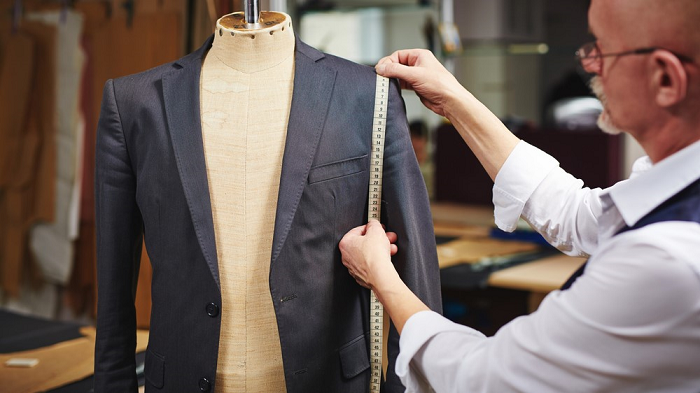Phase 2 — Developing Your Gentleman Spy Style
Lesson 1 — Style Basics
LESSON 1: Style Basics

The most visible part of living the Gentleman Spy lifestyle is the way you dress. Your attitude and your physique are both accentuated by the clothing and accessories that you wear.
With almost ninety percent of your body is covered by clothing, the choices you make here reflect the first impressions you'll make everywhere.
Before you spend money on new clothes, you need to get the basics right: fit, and tailoring.
Fit
Regardless of their personal style, most guys don't dress well, starting with the way their clothes fit.
Many men around the world, and most American men, wear clothes that are a full size too big, though the opposite is now starting to become common — skinny jeans and shirts that are too tight.
Your clothing, from the most relaxed to the most formal, should be comfortable, but not loose.
Dress Shirts
Collar — should graze, but not constrict, your neck. If you turn your head, the collar should stay in place; if it turns with your head, it's too tight. You should be able to comfortably fit two fingers inside the buttoned collar.
Cuffs — should sit at the very top of your wrist, about 1 inch (2cm) from your wrist bone. They should be tight enough that your thumb break keeps it from falling down over your hand, but loose enough to cover a wrist watch. If you wear particularly large watches, custom shirts or tailoring can often make one cuff larger to properly fit over your watch.
Shoulder — seam should be at your shoulder bone.
Sleeves — should be loose enough that you can't see the details of your arms, but not so loose as to billow. They should be long enough that when you bend your arm, the cuffs don't move more than an inch (~2cm) up your wrist.
Length — you should be able to move and bend naturally without the shirt coming untucked. True dress shirts that are always meant to be worn tucked in are longer, while more casual shirts are shorter and have a more squared profile at the bottom.
Torso — should fit snugly, neither straining when buttoned, or billowing outward.
Blazers and Suit Jackets
Collar — should allow 1/2 to 1 inch (~2cm) of your shirt collar to show above the jacket collar. Should touch and lay flat against the shirt collar, neither standing away from it, nor bunching up in the back.
Shoulder — seam should be at the edge of your shoulder. There should not be any bends or buckling where the sleeve hangs down from the shoulder.
Arm Holes — should be high, but not so high as to cut into your armpit. Higher arm holes allow the arms to move more freely and independently from the rest of the jacket.
Sleeves — should cover your wrist bone, but not further. They should not significantly restrict your movement. Your shirt cuffs should protrude below the jacket sleeve 1/4 to 1/2 inch (~1/2 to 1cm).
Chest — when buttoned, the jacket should not pull open (creating an "X") across the chest. Neither should it pull against the shoulders when your arms are crossed in front of you. Holding your hand flat, you should be able to fit it inside the jacket under the lapels, and the lapels should lay flat against the chest.
Buttons — the second button from the bottom should rest just above the belly button.
Length — the jacket should cover your butt. The bottom edge of the jacket should hit about the middle of your hands, with your arms hanging down at your sides.
Fit — if the jacket is too narrow in the waist, it may flare out at the bottom. From a more traditional cut for the larger man, to a very tapered cut for the athletic men, make sure you choose a jacket that is properly tailored to your physique.
Coats
Size — must be sized to fit over whatever you'll be wearing underneath.
Shoulder — like the suit jacket, should sit at the edge of your shoulder (keeping in mind what will be underneath).
Sleeve — should go about an inch below the wrist and should cover whatever you're wearing underneath.
Torso — should lie close to your body and not be too roomy.
Bottom — like the suit jacket, the bottom shouldn't flare out (indicating a size too small).
Chinos
Waist — should not need a belt to stay up and in place, but not so tight as to be constricting.
Pleats — avoid pleats, always choose flat front pants.
Legs — should fit close to the leg, but not snug or tight.
Length — a single break (crease) at the bottom, unless you're not wearing socks, in which case you want no break.
Dress Trousers
Waist — should not need a belt to stay up and in place, but not so tight as to be constricting.
Pleats — avoid pleats, always choose flat front pants.
Legs — should fit close to the leg, but not snug or tight. Dress trousers will drape more than chinos but should not billow.
Crease — dress trousers should have a single crease down the middle of each leg.
Length — should have single break (crease) at the bottom but should be smaller and less defined than the chinos.
Jeans
Cut — should be slim through the thigh, and straight or slightly tapered below the knee. Generally, you should avoid boot cut or excessive tapering below the knee.
Waist — size jeans by the waist. For a slimmer fit, go one size down — the jeans will stretch.
Length — the number of breaks is a matter of taste, but also the style and rigidity of the jeans. Length can also vary if you plan to cuff the jeans at the bottom, but for Bond's simple style, that would generally not be recommended.
Ties
Knot — will vary depending on the width of your shirt collar. A wider collar calls for a bigger knot like a full Windsor. A narrower collar calls for a smaller knot like a four in hand. The tie should not tighten your collar but should sit under it.
Length — a properly tied tie should sit halfway down your belt buckle when you're standing up straight.
Width — is a factor of your shoulder width and the width of the lapels of your jacket. As a general rule, match the tie at its widest point with the jacket lapels at their widest point. Most guys and most suits would call for a "normal" width tie. Skinny ties are reserved for tall, skinny men.
Shoes
Heel — should be snug. You should not be able to fit a finger behind your heel when standing in properly fitted shoes.
Width — the shoes should put little to no pressure on the sides of your feet.
Front — should not press on your toes. Your toes should not hit the front of the shoe but can lightly graze it (be careful when trying on shoes, as your feet expand when walking).
Tailoring

Finding is good tailor is paramount but is not the simple task that it used to be. Whether it's a recommendation from a friend, a coworker, or a menswear salesman, watch out: these recommendations are often because these men just don't know better, or don't know of a better option.
Know the Basics
Finding the right tailor starts with a proper understanding of fit and the basics of men's style. Read everything above about fit, then read the rest of the style section here. It's also a good idea to go to a few different stores and try on a bunch of different clothes to see what fits, feels, and looks best on you. You don't have to buy anything new yet, but you find out what you like before you start altering all your clothing.
Communication
Does your tailor speak your language? Many of the best tailors are Chinese, Thai, or Indian, so this can be as simple as making sure that they do in fact speak the same language as you do. But it goes further. Do they communicate well via phone, e-mail, and in person? When you ask for something, do they understand what you're really asking for, and vice versa?
Style and Samples
Does your tailor understand classic men's style? Just because they're a capable seamstress or tailor doesn't mean they understand what you want and need.
There are a great many talented tailors whose eye towards fabrics and fit are at odds with what you are looking for, so look at samples of what they've done before, pictures, alterations they've made, custom shirts, etc. You should be able to tell if they have an eye towards timeless men's fashion and if their style is what you're looking for.
Availability
The best tailors are in high demand. Wait times of weeks and months are not uncommon, but you need your tailor to be able to accommodate your needs quickly, especially if you need a quick fix before an event. Even the tailors in high demand will usually be able to work with you, knowing that it helps create a loyal customer.
Price
Only after everything else is in place — you understand the basics of men's style, you've talked to your prospective tailor and seen their work — does price come into play. Even for those without much money, price is the least important factor when selecting your tailor. You will get far more value out of a wardrobe and a tailor that fits and suits you perfectly than you will by having less-than-perfect clothing at a cheaper price.
Other Considerations
Spies, Secret Service agents, and security contractors around the world regularly wear body armor, pistols, first aid kits, radios, and more, all while looking impeccable in suits that don't show any of it.
If you tried to do the same with a normally tailored suit or jacket, you would look ridiculous with bulges everywhere or a jacket that looks absurdly small.
This is easily remedied, but you do have to plan for it.
When getting your clothing tailored, you need to consider how, when, and why you will wear them.
Whether you carry a big smartphone in a belt holster, a multitool, a pistol, or anything else, you need to wear it when going to get your clothes tailored.
A good tailor can help with more than just looking good.
You can have stiffeners sewn into the lining of the jacket so that it's easier to flip out of the way to draw your weapon, or you can have magazine pouches sewn into the pockets to carry spare magazines or multitools in a way that nobody but you would ever know. Anything from hidden pockets for your passport or extra cash, to handcuff keys, lock picks, or lapel daggers can be added to suits, jackets, or pants to give your more capability and more security while looking perfect.
Find a good tailor. Work with them until all your clothing fits like a glove, giving you the look and functionality you need.
NOTE: Adding hidden tools sewn inside your clothing is awesome tradecraft and is generally perfectly legal (check your local laws), but don't be stupid: you're not going to make any friends with the TSA or law enforcement if you get caught with these things.
PROGRAM
DOWNLOADS
 Clothing Checklist
Clothing ChecklistPrint out this checklist and use it when shopping, cleaning out your closet, or going to the tailor to make sure you get the perfect clothes and perfect fit.
Next Lesson...
Looking great every day shouldn't require rifling through your closet deciding on what to wear. Adopt a daily uniform to always look and perform your best.
